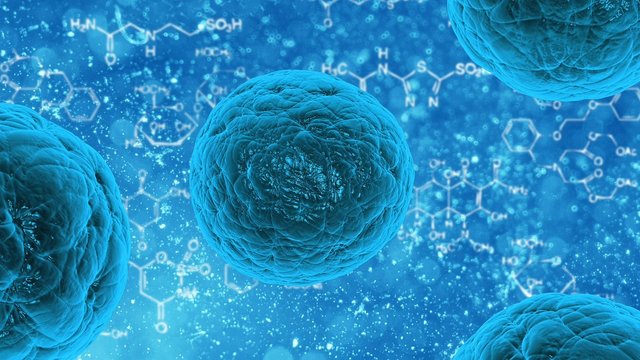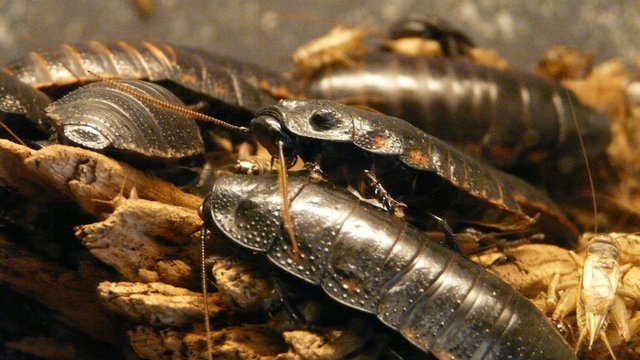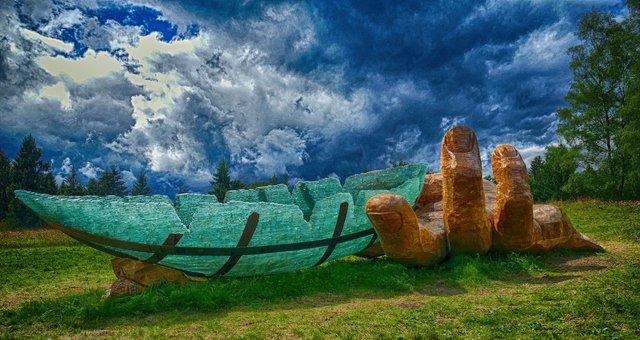FACT CANNON #8: The Ubiquitous Ark – An Alternative to Extinction

Don’t forget to save your work
Looking at the headlines at present, it seems that mankind is making really good progress towards a global catastrophe of some kind. Whether it’s over population, habitat destruction, global warming, the AI singularity or our old favourite thermonuclear war, it seems that some sort of mass extinction event is probably not too far around the corner.
Even though the vast majority of us aren’t hell-bent on destruction it appears that the people we voted in to represent us are. Sadly, despite the best efforts or our social reformers and ecologists, it seems that many of Earth’s major species (including humanity) may soon perish, so perhaps we need to look for alternatives to saving the actual organisms themselves.
Maybe we could explore keeping backup copies for future re-creation after the catastrophe?
Bursting full of information
Scientists successfully completed mapping a composite human genome in 2003, and gene sequencing is now commonplace, with the UK National Health Service’s imaginatively named ‘100,000 Genomes Project’ mapping the genomes of 100,000 individuals in 2018 to serve as a tool in the fight against many different diseases. Sequencing the whole genome of an individual is relatively inexpensive, in fact you can have your own genome sequenced for only a few hundred pounds. Sequencing the composite genome of a species of organism is more complex, although that process is also becoming commonplace. The genomes of thousands of species have already been mapped, covering all manner of bacteria, plants, fungi and animals. This list on Wikipedia gives a good idea.
So, we already have the data to backup a selection of our multitude of remaining species, and we can relatively quickly sequence the genomes of any other major species that we want to preserve. Once we have this data we can happily squirrel it all away to text files.
In terms of raw data, genome size is positively correlated to the complexity of an organism, although this rule does not always hold for species higher than the molluscs, where the genome’s load of ‘junk DNA’ (more properly referred to as non-coding DNA) starts to influence the size, but more on that later.
Genomes start very small at somewhere between 1 or 2kb for the ‘simplest’ viral particles, with a range of about 0.1mb to roughly 10mb for bacteria. Very approximately speaking, plants average around 100-200mb, with insects perhaps double that. Mammals tend to be in the 1-3gb range. There are outliers though, with the largest known vertebrate genome currently being that of the marbled lungfish, Protopterus aethiopicus, weighing in at a hefty 130gb, and the largest known genome of all being that of the canopy plant, Paris japonica, at a whopping 150gb. By comparison, man will take up a paltry 3.3gb of your drive. Note I am deliberately ignoring the huge size of the amoeba, Polychaos dubium, quoted at a disc-gobbling 670gb, largely because this is now understood to have been an error – it was measured in the 1960s when techniques were much less sophisticated, and it’s thought that the measurement accidentally also included the DNA of organisms the amoeba had ingested. See the table in this Wikipedia article on genomes for a few other sizes.
The chromosomes went in two by two… Hurrah! Hurrah!
To build our backup archive, we need to carefully select all the major organisms we want to preserve. This will include ourselves, our pets, a very select zoo of our most treasured and iconic mammals, birds, fish, reptiles and amphibians, and probably also some crustaceans and molluscs to cater for our taste for seafood and World Cup predictions. Let’s not get carried away though. We must be very selective here. We should be careful to minimise the storage space required by the archive, and we will of course also need to include all the organisms that make up our selected menagerie’s supporting food webs. We’ll also need things like soil creating organisms - bacteria, algae and fungi; and nematodes, insects and worms to aerate it; as well as an assortment of plants and their pollinators, and maybe even a handful of spiders to keep the arachnophiles happy. We’ll need to consider this across all of the terrestrial biomes we wish to preserve, not forgetting of course all the organisms necessary to create a viable marine and freshwater environment. We should also include a few creatures that prey upon our chosen zoo, and a small selection of the zoos parasites and diseases just to be on the safe side - we don’t want any single species running out of control in our post-apocalyptic paradise. Also, let’s not forget bacteria for decomposition – nobody wants loads of fully intact corpses scattered around messing the place up for all eternity. Finally, for the sake of data economy, let’s be careful not to include anything with freakishly large genomes. Sorry lungfish! (But don’t feel too left out, we’ll come back to you later).
So guesstimating, let’s say maybe 50,000 separate organisms. It’s impossible to be precise in terms of average genomic size, so erring on the side of caution let’s go with 500mb per organism. That’s 25tb, before compression. Genome data compression tools are available that could theoretically compress this 1200 fold, but for now we’ll stick to Huffman coding which is pretty much the standard for lossless data compression of genomes. Using DNAZip we should be able to achieve a compression ratio around 750 fold. This would give us a compressed archive size of roughly 34gb. The real file will probably be smaller than this - the repetitive nature of genomes makes them particularly suited to data compression, and there is currently much demand for new techniques, so it would be reasonable to expect compression rates to increase significantly as new technologies are developed over the next few years.
Ok, now we’ve got our compressed archive, containing the DNA recipes for all the species we want to inhabit our new stripped-down biosphere. For simplicities sake, and also because I think it’s clever, from now on I’m going to refer to this file as the ARKive ™.
How to keep a file for a very long time?

Now we’ve got our ARKive and we’re reasonably comfortable it’s fit for purpose, the question is where to store it to survive the coming apocalypse? Obviously, we could just pop out to PC World and get a very cheap hard drive (or in fact an SD card), but let’s remember here that our objective is for the ARKive to survive a mass extinction, which could well be the result of some sort of apocalyptic event. Hard drives are very resilient these days, and will generally weather reasonably high temperatures, but a thermonuclear detonation is going to be pushing it beyond operational tolerances. We’d struggle to retrieve anything much from a blob of melted slag or a cloud of metallic vapour, and it won’t be any easier to boot a lump of rust that has been submerged under 100m of water for a few centuries. In fact, just sitting around doing nothing, a hard drive will likely be unreadable after a decade or so simply due to magnetic field decay.
Solid state storage does not fare much better, and M-disc optical technology, the latest in data durability, will only last around an estimated 1000 years. That might sound fine, but it could take us orders of magnitude longer than that to rebuild any form of technological society able to learn to read these discs. What’s worse, it might be difficult for us to rebuild at all, given that over the last 200 years we’ve carelessly burnt all the reserves of any easily available fossil fuels any nascent new civilization would need to allow it to re-climb the technology ladder. No, for the storage to serve its purpose we need it to last long enough to allow the ARKive to be accessed by extraterrestrials, or even perhaps a newly evolved intelligent and technological species. For any hope of that it will probably need to last a VERY long time - let’s say 100’s of millions or even billions of years.
For genuine longevity we need to turn to a less synthetic medium.
A Brief Interlude for Questions
Before we get to the nub of this post in the next section, we should very quickly address the question of whether it’s actually possible to recreate a whole living organism from digital DNA. The answer is “Not just yet”, although scientists are making remarkable advances in this direction. Over recent years we have made huge leaps in several techniques we would need to achieve this. These include DNA printing, genome editing, chimera creation and cloning, among others. I don’t intend to go into these techniques in detail here, but the fact is that that while Jurassic Park may never happen (simply because it seems unlikely that we will ever retrieve any dinosaur DNA), de-extinction by genome editing is becoming a very real possibility in the not too distant future.
“Yes”, you say, “That’s all very well, but we’re potentially talking about re-creation of our DNA by an extraterrestrial civilisation”. That’s a good point. I will cover how they would find and recognise the ARKive later on, but would they know how to recreate the organisms stored in it? I suspect so – its highly likely that their life processes will have evolved using an information/code based system similar to DNA (if not DNA itself), and given that any sentient species is likely to be very curious about its own origins, they will probably be familiar with genetic coding systems and replication. If they possess technology capable of crossing interstellar space, we can expect that their other tech will also be much more advanced than ours. Simply put, if they are able to recreate a living organism from their own DNA-equivalent, which seems probable, it is highly plausible that they will be able to do the same thing from our own DNA. The issue of why they might want to resurrect what essentially amounts to a failed ecosystem is of course a question for another day!
Another question is whether a recreated human, grown and raised in a completely alien environment, with zero exposure to human culture or any other members of its species, would truly be a human at all. Also something to be explored another time.
Started doing it already?

So, back to the chase. Where can we reliably store the ARKive to last for a slice of eternity? Well, how about somewhere a little self-referential?
While researching my last article on the origin of terrestrial species, I came across the fascinating concept of storing data using DNA. This technology has already been proven. In 2012, George Church, an American geneticist and molecular engineer, stored a book, some JPEGs and a javascript program in naked DNA. Researchers have also stored a complete collection of Shakespeare’s sonnets and an audio file of Martin Luther King’s ‘I Have A Dream’ speech. We have, of course, read all of this data back again to prove that the technique works. While storage in this way is currently quite expensive, retrieval is relatively straightforward and cheap.
In fact, naked DNA proves to have a colossal data capacity, quoted as 5.5 petabits (that’s around 690tb) per cubic millilitre of DNA. But of course, it’s not going to last long enough for our purposes just sitting around in a test tube. For serious longevity, we need to incorporate it into the genome of a living organism.
The experiments discussed above all used naked DNA, which is DNA not associated with any proteins, lipids or other molecules to protect it. Presumably, the DNA used in these experiments has been stored in vitro in highly secure labs, and therefore the experiments only prove that naked DNA can be used as an artificial data store in a controlled environment. However, naked DNA can be genetically engineered into a living organism either directly, via engineered virus or a technology known as a ’gene gun’. If that naked DNA is successfully incorporated into an organism’s initial zygote cell, or into the germ cells of a parent organism, then the resulting organism should incorporate the DNA into its genome, and therefore it will be duplicated throughout the cells of the entire organism and passed on to its progeny.
It’s no great surprise that we have already done this. This Wikipedia article on DNA Computing states that Harvard Scientists have inserted a GIF of a galloping horse into the DNA of living bacteria. The bacteria subsequently reproduced, producing a sort of surreal rodeo in a petri dish, crammed full of bacteria each being ridden by their own little galloping horse. As documented in this article in the UK’s respectable Guardian newspaper, the researchers were able to extract and play the GIF from a bacterium of a later generation. We also have two scientists, Karin and Iztok Fister at the Universe of Maribor, who have led experiments to insert a python ‘Hello World’ program into a tobacco plant, and successfully retrieved and run it from seedlings of a later generation.
It’s fascinating to think that we already have the skills required to store many of humanity’s greatest cultural achievements in this way. Masterworks of art, music, writing, maybe even Wikipedia, could all be encoded for what could be eternal posterity. But perhaps the implications and ethics of this seem somewhat dubious. We can be confident that the results of these documented experiments are safely confined to their laboratories, and not happily seeding themselves in the wild. But can we also be sure that’s also the case for any undocumented experiments of this nature?
But that’s the whole point of this post.
Floating the ARKive

So now we come to the point. Although we can already splice digital copies of humanity's greatest masterworks into living organisms, perhaps we should consider splicing in something somewhat less trivial. Our ARKive, packaged in such a way as to be inactive, ie simply stored and not expressed by the host organism, effectively just an extra bit of non-coding ‘junk’ DNA. In this way we could take the concept of data redundancy to extremes, with an unimaginably large number of copies of our precious ARKive written into the cells of our most resilient organisms, and effectively preserved until the extinction of the very last of our toughest terrestrial species.
There are so many choices for potential hosts. How about splicing it into something really tenacious - rats or cockroaches, for example? Rumour has it that both of these species could survive a nuclear winter. Release them into the wild and watch them scurry around carrying out their usual day-to-day business, unwittingly stuffed full of copies of the ARKive - duplicating it and passing it on to their children as and when they grow and reproduce, ad infinitum. Another possibility would be a species that’s massively distributed across the whole planet, and therefore stands a chance of surviving a cataclysm – domesticated plants, springtails, tardigrades, yeasts or lichen, for example. Of course, the planet is also covered in a huge variety of extremophile bacteria capable of withstanding extremely hostile conditions, so these would represent another obvious class of host organisms. Needless to say, we could play the odds and insert it into a selection of hopeful candidates. Whichever organisms we choose here, the key is to splice in the ARKive, culture a population of hosts and then just let them out in the wild to do what they will. If we’re lucky enough to choose the right organism and it thrives after a mass extinction, its progeny should fill large numbers of ecological niches and we could even end up with a huge proportion of the emergent new ecosphere bearing the ARKive.
“But”, you say, “As the ARKive would be unexpressed within our host species’ DNA, wouldn’t it slowly degenerate due to replication errors over many generations?” Maybe not. This 2018 research article, ‘A highly parallel strategy for storage of digital information in living cells’ , by Azat Akhmetov of the University of Texas, proposes an encoding schema for eliminating errors of this nature, essentially by using redundant copies to work as a kind of checksum error correction mechanism. On this basis, it looks like it might be genuinely possible to float the ARKive in this way with our existing or very near future technology.
This method certainly appears to have legs (and roots and pseudopods), but as added insurance we could even pop the ARKive into the genome of a particularly hardy extremophile bacteria and blast a titanium test tube full of spores into high orbit where it should remain viable for aeons.
Looking for it in genetics
But how would anyone looking to read the ARKive and recreate our biosphere know where to find it? Well, the ARKive solution has two great features in this respect…
- Assuming the search is happening in the near term, ie mere millennia after the insertion of the file, and before a mass extinction event, any organism hosting the ARKive would have a genome somewhat larger than similar organisms, as the ARKive itself is fairly sizeable in terms of raw data. So, a straightforward analysis of genomes for ones with statistically diverging sizes would pull out likely host species.
- Secondly, if the search happens aeons after the splicing, it will likely be after a mass extinction event of some kind. In this case, assuming our chosen host is lucky enough to be one of the small percentage of surviving organisms, then we could reasonably expect its descendants to have flourished in the numerous vacant biological niches that will have opened up, and be playing a major part in the new post-apocalyptic biosphere. In this scenario, we could expect a sizeable proportion of all of the planets species to have inherited the ARKive. So long as we have encoded some obviously artificial header data at the start of the ARKive a simple genome scan of a selection of widespread organisms should identify the payload. Picture this… Two billion years in the future - a massive natural field of grain analogue, abuzz with pollinating critters and growing in a rich soil teaming with fungal and microbial life; small mammal-like animals, themselves crawling with billions of parasites, gorging on abundant creepy crawlies; bird-like beasties wheeling on thermals overhead in an evening feast of swarming bugs. With each cell of each plant or critter containing the backups of a huge menagerie of long lost lifeforms, ready to be read and recreated by anyone who cares to look hard enough.
One footnote here, we should be very careful to learn to read before we start writing. Before we charge off and splice our ARKive, or in fact any other data, into living genomes, perhaps we should come back to our lungfish and japonica plants and intensively analyze their bloated non-coding DNA? Building on my previous articles about panspermia, is it possible that someone else may have already left their own ARKive in them? And in relation to my second point above, shouldn’t we also go through the junk DNA of a huge selection of organisms looking for a common artificial header code?
Panspermia may not be mainstream science yet, but it is very plausible, and we have not ruled out the possibility that terrestrial DNA arrived from space. As we have found, DNA is potentially one of the best communication mediums available in a universe where intelligent beings may be just as separated in time as they are in space. Let’s not make it harder to read by stuffing it full of graffiti beforehand.
Endless Green

So here we are…
After the West Antarctic ice sheets collapse, the oceans rise 7 meters. Encroaching waters render many major coastal cities uninhabitable, triggering famines and epidemics, and an unimaginable mass migration of displaced humanity. Global political tensions soar to an irreversible boiling point, the crazies in charge scratch their itchy trigger fingers and 98% of the planets species perish in the inevitable thermonuclear apocalypse and ensuing centuries of global winter. Although small bands of humans initially struggle to form new communities in extremely remote areas, their over-specialisation and residual reliance on now useless and unmaintainable technology renders their efforts fruitless, and after a few decades of gruelling subsistence living in an increasingly harsh environment they ultimately fail to thrive and the last of them disappears from the face of the planet.
Centuries, millennia, aeons pass. The biosphere repairs itself, new species arise from the scattered survivors and fill vacant and emerging ecological niches.
ET finally arrives, his vessel descending silently through brooding dark clouds, touching down on a rainy day in a field of drab khaki shrubs. His flying saucer crushes an elaborate crop circle of broken bushes into the rich loamy soil. The hatch hisses open and he releases his genome scanning drone, its AI primed to return a sample of any organism with a genome appearing to contain an artificial archive. It’s a short trip on this particular planet, and it whirs back to him from one of the ubiquitous plants. With a click it deposits what appears to be an olive leaf into his outstretched webbed palm.
The rain eases a little, the clouds part, shafts of golden sunlight break through, and a continent-spanning vista of wind-rippled jade and emerald plants stretches out as far as his compound eye can see. A rainbow stands proud across the vale.
FACT CANNON: Still afloat on a rising tide of indifference
Inspiration:
https://en.wikipedia.org/wiki/Human_Genome_Project
https://en.wikipedia.org/wiki/100,000_Genomes_Project
https://en.wikipedia.org/wiki/List_of_sequenced_eukaryotic_genomes
https://en.wikipedia.org/wiki/Marbled_lungfish
https://en.wikipedia.org/wiki/Polychaos_dubium
https://en.wikipedia.org/wiki/Paris_japonica
https://en.wikipedia.org/wiki/Genome
https://en.wikipedia.org/wiki/Compression_of_Genomic_Sequencing_Data
https://en.wikipedia.org/wiki/De-extinction
https://en.wikipedia.org/wiki/George_M._Church
https://en.wikipedia.org/wiki/DNA_digital_data_storage
https://en.wikipedia.org/wiki/DNA_computing
https://en.wikipedia.org/wiki/Plant-based_digital_data_storage
https://bmcbiotechnol.biomedcentral.com/articles/10.1186/s12896-018-0476-4
Image Credits:
All images released free of copyrights under Creative Commons CC0. Rainy Out (733215), Lock Up (Reimund Bertrams), Balls of Life (Public Domain Pictures), Roaches (Hans Braxmeier), Handy (Saluto). All from Pixabay.com
Previous editions of FACT CANNON you might find interesting:
FACT CANNON #5: The Origin of Life on Earth – Panspermia and Cosmic Ancestry
FACT CANNON #6: Recent Evidence For Panspermia
FACT CANNON #7: Solving the Fermi Paradox – DNA as a von Neumann Probe
FACT CANNON #3: The Sad Tale of Paul The Psychic Octopus
If you enjoyed this edition of FACT CANNON, please upvote, comment, share and follow me. There’s plenty more of this stuff if you’re interested!
Congratulations @matrioshka! You have completed the following achievement on the Steem blockchain and have been rewarded with new badge(s) :
You can view your badges on your Steem Board and compare to others on the Steem Ranking
If you no longer want to receive notifications, reply to this comment with the word
STOPDo not miss the last post from @steemitboard:
Vote for @Steemitboard as a witness to get one more award and increased upvotes!
Nice intresting work for gathering facts
Thanks, glad you enjoyed it.
You got a 4.85% upvote from @minnowvotes courtesy of @matrioshka!
You got a 71.43% upvote from @brupvoter courtesy of @matrioshka!
Congratulations @matrioshka! You received a personal award!
You can view your badges on your Steem Board and compare to others on the Steem Ranking
Vote for @Steemitboard as a witness to get one more award and increased upvotes!